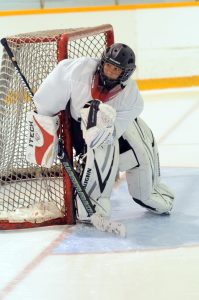Behind The Net
No goaltender is too young or inexperienced to be taught the proper technique for behind the net plays.
Although beginners may not quite understand how to shuffle properly, they should still be taught the importance of stick and glove placement, timing, and positioning.
Proper technique should be taught as early as possible in this respect, and the glove and stick should be positioned in a way that will prove effective. At GAAHockey, we teach our students that they can stop a shot before it occurs by placing emphasis on challenging and cutting off the pass. Goaltender-specific power skating exercises should include both challenging movements to develop balance, speed, and agility, as well as correction of any potential gaps in the goaltender’s technique. Especially at the earliest stages. If anything, the youngest goaltenders need to understand the Why’s and the How’s the most.
For the video demonstration, the goaltender should be placing more emphasis on doing the exercise with proper technique by attempting to cut off the imaginary pass from below the goal line, both high and low. By doing so, the goaltender will build a solid foundation which they will eventually apply naturally during their games for any play behind the net and below the goal line.
The blade of the stick should therefore be placed as close to, if not on the goal line on both sides, and the glove’s palm and pocket facing toward the puck to take away a potential saucer pass over the blade of their stick.
Balance and Weight Distribution
While doing this exercise, young or beginner goaltenders may have trouble with their balance as many tend to lean on the post. It is very important for their weight to be equally distributed over both of their skates. Equally important, the knees will need to be bent in order to allow for a quick, explosive push off of the post in the event that they were unable to cut off the pass, and to be in position for the next pass or shot. You can see in this video that the goaltender’s shoulders move up and down during his strides. This is an indication that he does not keep a consistent bend in his knees and will therefore not be as prepared as he could be off of the post for a quick pass to above the goal line.
Visualization Is Key
While doing this exercise, the goaltender should ensure that they are simulating the play through visualization of the puck. By doing so, they will better prepare themselves to maintain visual contact of the puck in a game when it matters most. They may do this with a 4-Window approach.
Behind the Net: The 4-Windows
The 4-Window approach allows the goaltender to cut off the pass at the post, and be on time for passes from behind the goal line. The 1st window position is situated at the post. Simply put, the goaltender’s skate is against the post, the blade of their stick is along the goal line, and their glove challenging the pass. For this window, the puck’s position should be anywhere between the post and the corner, while being below the goal line. The 2nd window is a quick shuffle to the centre of the net while still maintaining visual contact of the puck by looking over the same shoulder and through the net (not looking over the crossbar). For this window, the puck should be positioned below the goal line and anywhere between the post and the centre of the net. The 3rd window is a quick turn of the head to look over the opposite shoulder and through the opposite side of the net. For this position, the puck should cross the mid point of the net, and be positioned between the mid-point and the opposite post. The 4th window is another quick shuffle to the opposite post allowing the goaltender’s skate to get up against the post, while the goaltender swings the blade of their stick around the post and onto the goal line. The glove should also be positioned with the palm facing out toward the puck again. For this position, the puck should be situated below the goal line anywhere between the corner and the post.
Other Theories
There are theories which dispute the centre of the net being the most favourable point to turn one’s head. Other theories include maintaining visual contact of the puck over one shoulder until reaching the opposite post, and then turning the head upon losing sight of the puck. The problem with this theory is that if upon reaching the opposite post and then turning their head due to having lost sight of the puck for a fraction of a second due to having to turn their head, the goaltender may not be in position by the time the puck reaches the receiver of the pass positioned in front of the net. The demonstration video will show the goaltender turning their head at the post, then pushing to the opposite post. This method may only cause problems for a goaltender if they happen to turn, & leave the post too early as the puck carrier behind the net may see their chance and change direction while the goaltender is in motion, leaving the starting post position open for a wraparound or pass to above the goal line.
The Break Out
The 4-Window approach will allow the goaltender to keep pace with the puck during all movements below the goal line. In the event that the goaltender loses sight of the puck behind their net (at centre) by turning their head while the shooter goes toward the opposite direction, the goaltender will have a fraction of a second of additional time to either reach the post for a wraparound by dropping their knee and pushing into a butterfly slide against the post compared to other methods. In the event of a pass from below the goal line they will also have an additional fraction of a second to push out from the centre of their net to the correct depth of their crease in order to cut off their angles than they would have if they waited to get to the post, turn their head, and then react to the pass.
As I’ve mentioned in previous posts, there is no wrong way to stop a puck. However, there are better ways to ensure maximum efficiency through practicing and applying proper technique, and positioning.



Leave a Reply